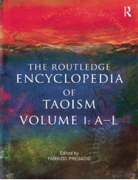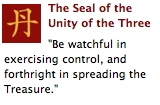Sample Entries
Daode jing (Scripture of the Dao and Its Virtue), by Isabelle Robinet
"The Daode jing, also known as Laozi, is ascribed to Laozi, who allegedly gave it to Yin Xi as he left the Middle Kingdom to go to the west. Scholars have long debated its authorship and date. . . ." (Read more)
Daojia (Taoism; "Lineage[s] of the Way"), by Isabelle Robinet
"The term daojia is a topic of debate among scholars, mainly concerning whether early Taoism constituted a 'school' or 'lineage,' as the term jia seems to imply, and the distinction between daojia and daojiao, which is often understood to mean the religious forms of Taoism. . . ." (Read more)
Daojiao (Taoism; Taoist teaching; "Teaching[s] of the Way"), by T.H. Barrett
"This term, now denoting the religion which is the topic of this encyclopedia, originally meant no more than 'Teaching of the Way'--though even this is misleading, in that inculcation rather than education is implied by 'teaching.' . . ." (Read more)
Daozang (Daoist Canon) and Subsidiary Compilations, by Judith M. Boltz
"What has popularly come to be known as the Daozang (Taoist Canon) is indisputably the foremost body of texts for research in the field of Taoist studies. The Ming Canon of 1445, or so-called Zhengtong daozang (Taoist Canon of the Zhengtong Reign Period), lies at the heart of all modern editions of the Canon. . . ." (Read more)
Jiao (Offering), by Poul Andersen
"The term jiao means "offering" or "sacrifice." It refers, in the present day, to the large-scale Taoist ceremonies organized by local communities, and by other social groups such as professional guilds and various forms of voluntary religious associations, in order to define themselves on the religious level, and specifically in order to establish or confirm the (semicontractual) relationship between the group and its tutelary deity. . . ." (Read more)
Jindan (Golden Elixir), by Fabrizio Pregadio
"Modern studies usually refer to the Chinese arts of the elixirs as Waidan (External Alchemy) or Neidan (Internal Alchemy), but the authors of alchemical texts often call their tradition the Way of the Golden Elixir (jindan zhi dao). Gold (jin) represents the state of constancy and immutability beyond the change and transiency that characterize the manifested world. . . ." (Read more)
Lingbao (Numinous Treasure), by Stephen R. Bokenkamp
"The name lingbao (Numinous Treasure) was originally a description of a medium or sacred object (bao, 'treasure') into which a spirit (ling) had descended. Seemingly, the first scripture to use the name, thus indicating its own status as spiritual treasure, was the Lingbao wufu jing (Scripture of Five Talismans of the Numinous Treasure), the surviving edition of which, the Lingbao wufu xu (Prolegomena to the Five Talismans of the Numinous Treasure), contains passages which were cited by Ge Hong in his Baopu zi. . . ." (Read more)
Quanzhen (Completion of Authenticity), by Vincent Goossaert
"Quanzhen is today the main official branch of Taoism in continental China. This status is not primarily due to its doctrines, for Quanzhen tenets do not radically differ from those of other Taoist schools, but rather to its celibate and communal mode of life. . . ." (Read more)
Shangqing (Highest Clarity), by Isabelle Robinet
"The term Shangqing initially denoted a corpus of scriptures revealed to Yang Xi (330-86) between 364 and 370. With later 'apocryphal' texts, these scriptures were adopted by the southern Chinese aristocracy in the fifth and sixth centuries and were assigned the highest rank within the Three Caverns (sandong) of the Taoist Canon. . . ." (Read more)
Tianshi dao (Way of the Celestial Masters), by Terry Kleeman
"The founding of the Way of the Celestial Masters or Tianshi dao in modern Sichuan province during the 2nd century CE marks the formal establishment of the Taoist religion. The movement traces its origins to a dramatic revelation to Zhang Daoling in 142 CE, when Laozi descended to him atop Mount Heming (Heming shan) in order to establish a new covenant between the true gods of Taoism and the people. . . ." (Read more)





